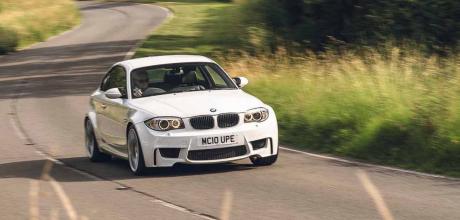2011 BMW 1M Coupe E82
The pugilistic 1M Coupe E82 was BMW M Division's first turbocharged car. Glen Waddington reckons it turned out to be quite the gamechanger.
Photography Jordan Butters
PUNCHING ABOVE ITS WEIGHT
Not a real M-car? Surely it's one of the best!
For obvious reasons it couldn’t have been called the M1 E26. That name belongs to the seminal mid-engined coupe of 1978, though even that wasn’t M’s first product. The BMW Motorsport story goes back to the delectable 3.0 CSL E9 that was a six-time winner of the European Touring Car Championship between 1973 and 1979, but the first BMW to wear an M badge was actually a somewhat obscure South African-market saloon racer, the E12 530 MLE of 1976.
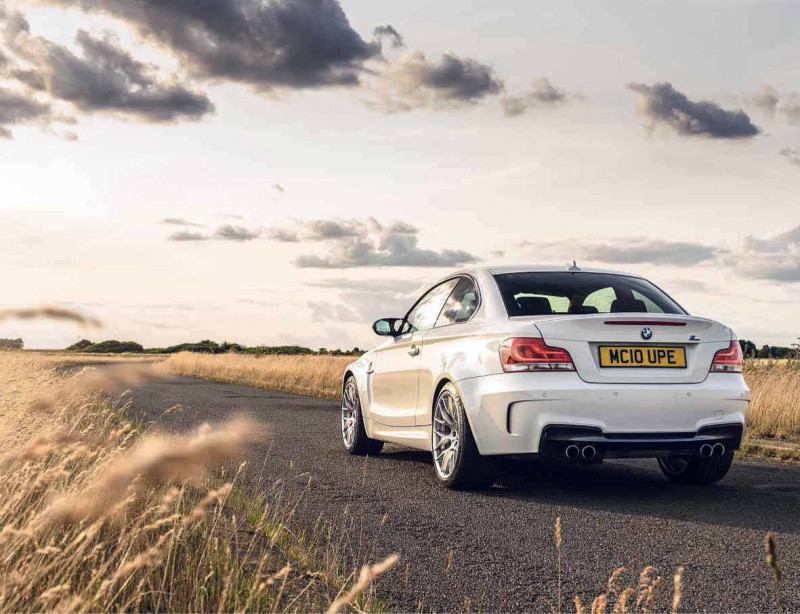
So, no matter that the M is a suffix rather than a prefix, the clumsily titled BMW 1-series M Coupe E82 (we’ll call it the 1M) is a proper M-car. Or is it? You see, many were those at the time who felt that any BMW worthy of that haloed letter — before or after the series number — really ought to be naturally aspirated. After all, every M-car before then had been. But the 1M E82 was turbocharged. Twin-turbocharged, in fact. Is that a problem? Or was it an opportunity? We’re here to find out.
There were other doubters, too. Not only was that engine turbocharged, it was also pinched from another BMW, namely the Z4: M-cars traditionally had a bespoke, handbuilt engine, not one opportunistically plucked from the production line of a handy roadster, even if it was a powerful and quick one. Indeed, the 1M was a bitza all-round. But there’s good reason for that, and the principal donor was a bona fide legend, which we’ll come to.
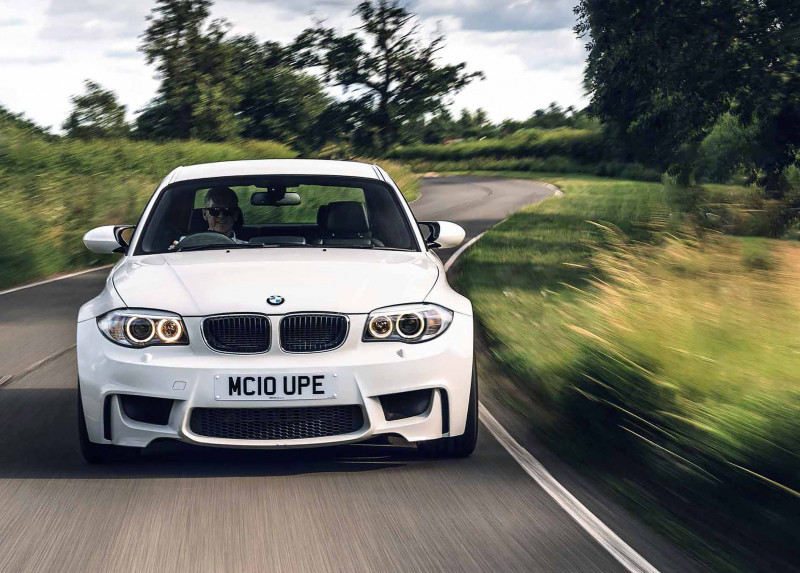
Fact is, the 1M E82 was launched in 2010, when the world was reeling from the credit crunch and car manufacturers were having a particularly hard time. While Audi famously claimed that it was declining to take part in the financial difficulties rife elsewhere, Ford was busy offloading Jaguar, Land Rover and Aston Martin, and GM let Saab go to the wall. But a rogue gang of engineers within BMW saw the 1-series as an ideal basis for an M-car: compact, relatively lightweight, rear-wheel-drive. And anyway, if any performance car were going to stand a chance of success in those straitened times, surely better for it to be based on the bottom of the range?
BMW’s directors were reluctant to grant development cash but grudgingly gave permission to create an uber-1 with parts pilfered from the E90-generation M3 and the Z4’s 335bhp twin-turbo 3.0-litre straight-six and six-speed manual transmission. Hardly a bad bunch of bits, especially given the breeding of the M3 — a genuine M-car. This was the one-off V8 generation, its 4.0-litre engine based on the crazy 5.0-litre V10 of the E60 M5. Bespoke indeed: these are the only M-car engines that didn’t share any commonality whatsoever with standard BMW ones!
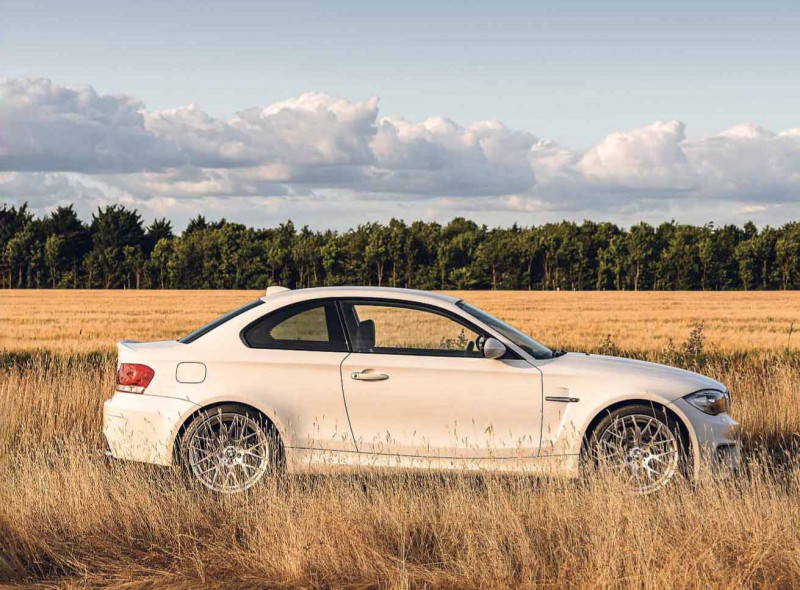
So the M3 handed over its rear suspension, limited-slip differential and brakes, plus delectable multi-spoke wheels and aero-style mirrors. Given that the rear axle was several inches wider than what was usually between the ler’s wheels, the bodywork had to be beefed-up to keep it shrouded. Likewise, the front wheelarches were flared significantly, filled by those gorgeous 18in alloys, and a ventlike vertical crease was let into the wing pressings to bring some harmony to the reworking. Out back, a new valance sat above two pairs of tailpipe. The 1-series boot-lid was already shaped to incorporate an aerodynamic swelling, rather like that of the E46 M3 CSL. Here it’s adorned with a simple ‘M’ badge.
It’s certainly got more attitude than the banana-silled bathtub style of Chris Bangle’s original creation. Perhaps that’s a little harsh, as the I er was launched as a five-door hatchback, the first downward extension of the BMW range and basically a cramped, less practical Golf rival for badge snobs or those who couldn’t stretch to a 3-series. That initial offering grew to include a three-door, the two- door coupe and a matching convertible. And… they were all rear-wheel-drive! Smaller BMWs aren’t any more — they’re all based on Minis — so let’s celebrate rather than denigrate.
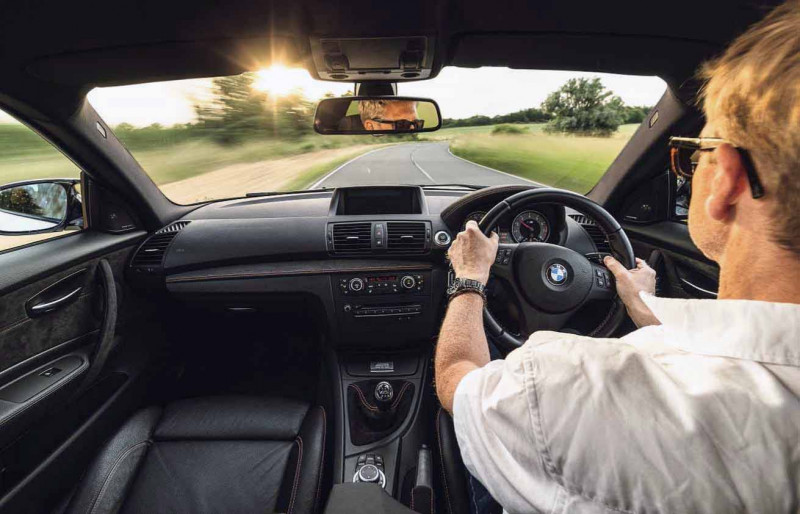
Those engineers had been gifted a cracking basis in the 1-series, given that the result was 50:50 weight distribution, and the project was turned around in just a year. It was only made for 2011, with a few sold the year after, for a total just past 6000 in Europe and the USA. The UK received its quota of only 450, thankfully all right-hand-drive, offered (plus options) from £40,020. That put it bang in Porsche Cayman territory, around eight grand up on the erstwhile range-topping 306bhp 135i E82, about which in 2007 Top Gear magazine had said: ‘This 135i Coupe is the M1 of the range. Don’t let BMW hear you calling it that — it’s highly unlikely anything of the 1-series’ ilk will ever get the same name that adorned that iconic 1970s supercar. But with 302bhp and a 0-62mph time of 5.3 seconds, they might as well have slapped an M badge on it somewhere.’
Then, surprise, surprise, along came an ‘M1’ — or 1M — and when Car magazine got hold of one as a long-term test car in 2011, the former evo road test editor Jethro Bovingdon was moved to write: ‘I’m over the moon to be running the new baby M-car. I love M-cars, love the look of the pumped-up 1M and have been begging Car for a rear-drive long-termer for some time… I didn’t expect it to pay off quite so spectacularly.’
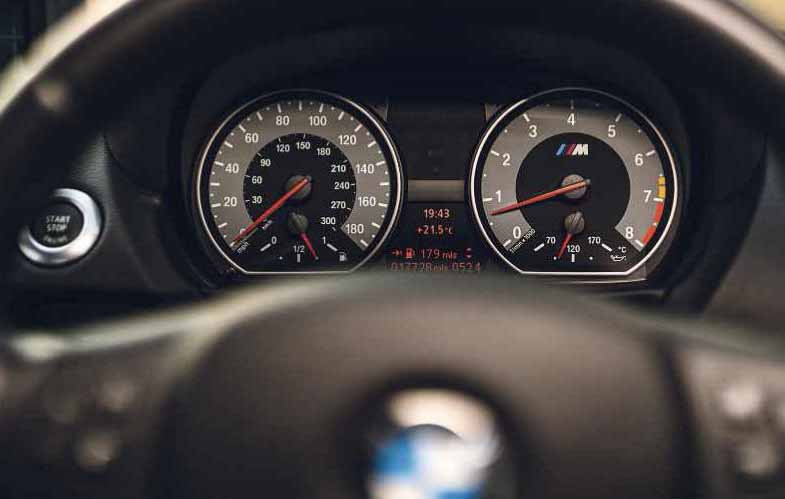
For comparison’s sake, the 1M’s figures — thanks to its additional 33bhp — are 4.8sec for the 0-62mph sprint and it’s capable of way more than the 155mph it’s limited to. Its 40-grand retail price is also significant, as most decent 1Ms are still offered for that kind of money. Indeed, if you can find something like the wonderful sub-18,000-mile car we have here (it belongs to BMW UK’s heritage fleet), you’ll be paying rather more, perhaps £60,000, even £80,000. They’re loved by enthusiasts and collectors alike; not bad for a mud-blood. This is one of those limited-production cars, rather like a BMW M3 CSL E46 or Porsche 911 997 GT3, that just hasn’t depreciated.
So perhaps it really is rather more special than that parts-bin rep would have it. Only one way to find out. Swinging open the frameless door reveals quite a simple interior, with supportive-looking buckets swathed in leather, while fake suede adorns the (very) fat-rimmed steering wheel, the doorcards, doorpulls and instrument binnacle, and there’s a strip across the centre-dash that disguises a piece of plastic I recall as being surprisingly cheap-feeling back when I last drove a 120d in about 2009. Funny how these things come back to you.
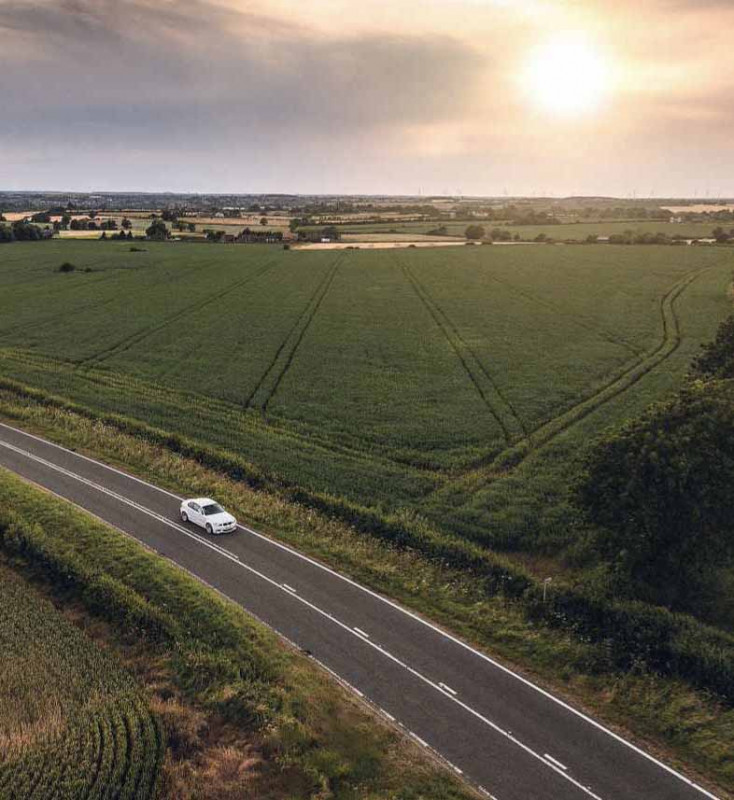
Within that binnacle are a speedo, rev-counter, even an oil temp gauge — proper ones with needles — and while BMW’s iDrive knob commands a central screen, it’s unobtrusive. Even better, there’s a stubby central lever for the six-speed manual box, and an old- fashioned handbrake! Yes, the 1M is new enough that the latter is actually a surprise.
So this is what these days we refer to as an ‘analogue’ car, and it dates back to the era when manual transmission and proper handbrakes were beginning to disappear from high-performers. While the standard 1-series foisted electrically assisted steering on its driver (part of BMW’s ‘Efficient Dynamics’ package at the time, which included a start/ stop device), there’s an actual hydraulic rack here, thank goodness.
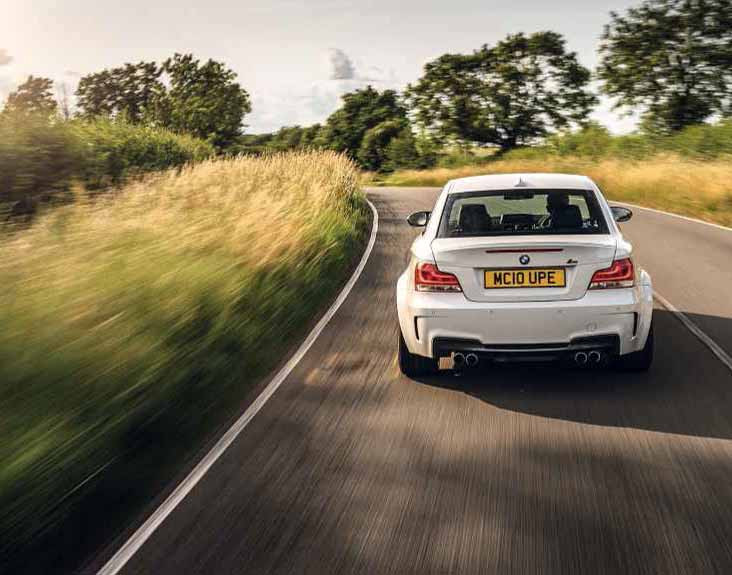
The door clunks shut and I stab the Start button, the response to which is a muted woofle. It’s recognisably the voice of a BMW straight-six but it’s surprisingly quiet. Pull away and the whole thing feels exceptionally refined: the ride, although firm, seems to leave a fine layer of velvet between tarmac and tyres, and the gearshift is accurate, satisfying, yet oiled and easy. There’s a Terrier-like look to the 1M E82 but it doesn’t seem to bare its teeth quite so readily. Perhaps there’s more 1-series than M-car in here after all.
But then I spot the ‘M’ button on the steering wheel spoke, and a swift prod with my right thumb brings a much sharper throttle response. Nothing else, no tightening of dampers, no extra heft to the steering: everything is just so, as the engineers intended, but gone is the shopping-friendly progress and in its place a much more rabid feel to proceedings. Yes, it’s an M-car; it just needed to be turned on.
It’s quick, very quick. Pin the accelerator and you’re briefly treated to an overboost’ that summons a peak of 369lb ft — lots for the sub-1.5-tonne kerb weight. You’re not wringing out to a ridiculous rev limit, you don’t even need the 6500rpm that’s permissible, because those turbos do all the heavy lifting, delivering each corner with vanishing rapidity, and so couth is the soundtrack that it feels effortless.
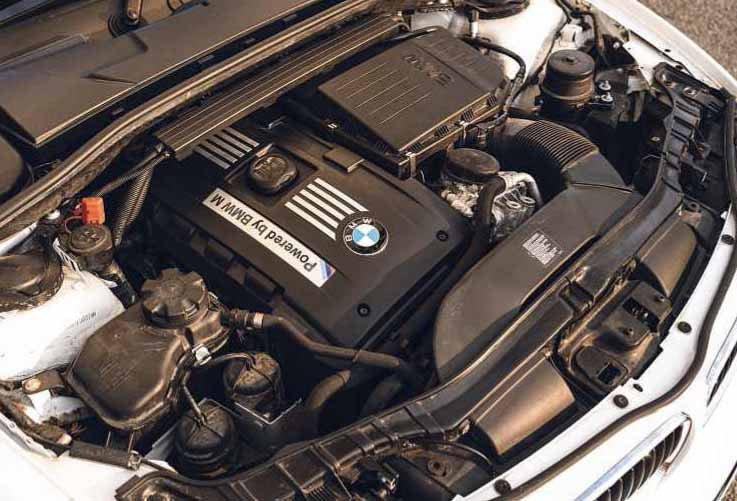
What’s missing is the visceral nature of an M3 CSL, largely wrought by its improved breathing, which brought an intake snarl that’s overwhelmingly addictive. But if the 1M was your introduction to BMW’s more special breed, you wouldn’t miss that. It’s still a gorgeous sound, steely and aristocratic, and the sheer thump all that torque brings puts a smile instantly on your face.
It’s down to the handling to keep it there, and even an initial foray is promising. The steering is slightly numb in the grand scheme of things, though it’s talkative in comparison to most cars of today. More importantly, turn-in is completely on point, no dallying at all, so the 1M brings the fight to a British B road and the engine provides the killer punch.
Of course, something so powerful and with such a short wheelbase could bring trouble any night of the week, yet still it’s a surprise to find that the traction control wades in pretty earnestly if you overcook things, cutting power like a bouncer quells a quarrelling nightclub queue. So I grow a pair, prod the ‘MDM’ (M Dynamic Mode) button and suddenly find that all there is between me and a big slide is the tyres and a slippery diff.
So, a gamechanger, then? Well, turbocharging soon became the norm for M-cars, beginning with the next-generation M3 and M4, plus the M2 that succeeded the 1M. Yes, BMW decided on the back of this car that its babiest coupe deserved the full treatment.
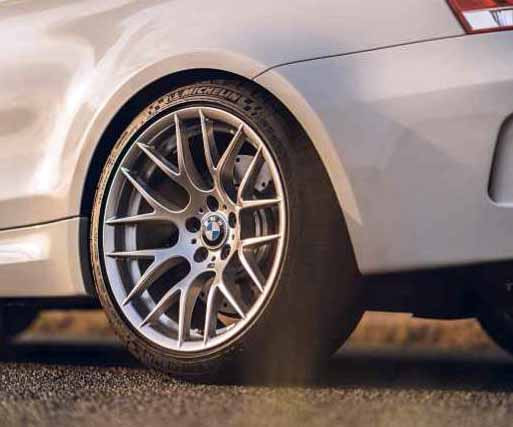
But the 1M’s influence goes even further: so many performance cars that followed went the turbocharged route. Emissions targets forced the change: BMW backed away from its V8 M3 E92 and V10 M5 E60, and force-fed sixes — even fours — are now the norm; witness various AMG Mercs, as well as the Porsche 911, Cayman 718 and Boxster. Alfa Romeo’s scintillating Giulia Quadrifoglio replicates much of the 1M’s mechanical package, though sadly gone are the days of a default stick-shift, or often even a stick at all. That’s where the 1M really scores.
The upside is cars that blow our minds with the power they provide, reliably, on demand, and while we might wish for the coruscating rev limits of such outliers as the Porsche Cayman GT4 RS — and admittedly, that 9000rpm shriek is narcotically moreish — there comes with that kind of exotica a potentially high price in terms of maintenance as it ages.
BMW’s 1M turned out to be a lesson in pragmatism: give us a kit of parts and just look at what we can do with it. Even its spiritual successor, today’s M2, has more in common with the current M3 than it does the standard front-wheel-drive 1-series, employing the rear-drive powertrain of its bigger sibling.
That the 1M has managed to charm a generation of enthusiasts brought up on cars with loftier ideals to match their own speaks volumes for what M Division’s maverick engineers achieved in economically difficult times, and how prescient they turned out to be, given the eco-driven moves that have since followed. Some say it’s not an M-car. I say it’s one of the very best.
TECHNICAL DATA 2011 BMW 1M Coupe E82
- Engine 2979cc DOHC 24v twin-turbo straight-six, Bosch electronic fuel injection and engine management
- Max Power 335bhp @ 5900rpm
- Max Torque 332lb ft @ 1500-4500rpm (overboost: 369lb ft)
- Transmission Six-speed manual, rear-wheel drive, limited-slip differential
- Steering Rack and pinion, power-assisted
- Suspension Front: MacPherson struts, coil springs, anti-roll bar. Rear: multi-link, coil springs, telescopic dampers, anti-roll bar
- Brakes Vented discs, ABS
- Weight 1470kg
- Top speed 155mph (limited)
- Acceleration 0-62mph 4.8 sec
Opposite page, and above Corners are the 1M's natural habitat, though things can get very interesting when you disable the traction and stability control; plenty of power and torque from Z4-sourced twin-turbo six.
‘IT’S GOT MORE ATTITUDE THAN THE BANANA-SILLED BATHTUB STYLE OF CHRIS BANGLE’S ORIGINAL’
Clockwise, from above There's a lofty redline but you don't need all those revs; long straights feel much shorter than they look; pumped-up bodywork clads beefed-up running gear and powertrain.
BMW 1M E82 OR ONE OF THESE? FOR A FEW DOLLARS LESS
Big six into smallish car will go — and you might even consider a brand new alternative
THE LEGEND
So many bits have been pilfered from various M3s to build the 1M and its descendants, why not buy the real thing? The original E30 M3 is a very different beast, and even the E36 that supplanted it is rare-groove and collectable. But you'll find a fantastic E46-generation car (below), with a gloriously charismatic, naturally aspirated 3.2-litre 24-valve straight-six, a sublimely beautiful body and build quality from an era before even BMW was forced to count the pennies. Shall we open the bidding at £15,000? Plenty to choose from, though naturally we're going to have to forgo the ultimate CSL on this budget.
Of course, while six cylinders are the norm for a BMW coupe, there was also that slightly unhinged V8-engined E9x generation — and you can have it with two doors (E92) or four (E90, above). It sounds delectable, goes hard, and can be had as a manual. It’s a heck of a car for £20,000; pay £35,000 and you'll find a peach with minimal mileage — and, thanks to that specially developed V8, it's something the like of which BMW has never replicated since.
THE CHEAPO
Remember what Top Gear said about the 135i (above) being worthy of an M badge? I well remember my first blast in one, which involved a brief spell sideways on a straight road. No limited-slip diff so it's distinctly lairy, but it's great fun and ten grand comfortably buys a belter.
The next generation, from 2011, split 1-series hatches from 2-series coupes — and finally brought an M badge to the boot-lid, with the advent of the M135i (above right) and M235i in 2014.
More of the same, with a big twin-turbo six in a compact body, slightly more grown-up, less lairy and not quite so cute. Yours from around £12,000, and as evo called it: ‘One of the high points of the entire BMW range, a compelling mix of dynamic ability, performance and affordability.'
Not quite a 1M or an M2, but properly compelling performance for your pound.
THE NEWBIE
For rather less than the price of a good 1M you could have a first-gen M2 (above), the best-selling M-car so far. Launched in 2016, though nothing like as rare, it was a far more mature effort than the 1M, though related mechanically with a very similar engine and six-speed gearbox (a seven-speed dual-clutch transmission was optional). Pumped-up bodywork clad wider tracks; a good one is around £25,000.
Find another ten grand or so and you can upgrade to the rather more legendary M2 Competition, its M GmbH S55 engine taken from the F80 M3, with a closed-deck block, lightweight crankshaft, strengthened pistons and rods and a 405bhp output.
For top-end 1M money you could buy new. The latest 454bhp M2 (above right) is basically a shrink-wrapped M4, so it's no lightweight at 1700kg, but spec a manual 'box (a £545 option on top of the £65,000 asking) and it's the swansong of an increasingly rare breed.


